No. 7. Ponderosa Pine Forest and Woodlands
(includes Eastside Oak)
Rex C. Crawford and Jimmy Kagan
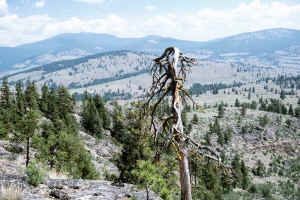 Geographic Distribution.
This habitat occurs in much of eastern Washington and eastern Oregon, including
the eastern slopes of the Cascades, the Blue MOuntains and foothills, and the
Okanogan Highlands. Variants of it also occur in the Rocky MOuntains, the
eastern Sierra Nevada, and mountains within the Great Basin. It extends into
south-central British Columbia as well. Geographic Distribution.
This habitat occurs in much of eastern Washington and eastern Oregon, including
the eastern slopes of the Cascades, the Blue MOuntains and foothills, and the
Okanogan Highlands. Variants of it also occur in the Rocky MOuntains, the
eastern Sierra Nevada, and mountains within the Great Basin. It extends into
south-central British Columbia as well.
In the Pacific Northwest, ponderosa pine-Douglas-fir woodland
habitats occur along the eastern slope of the Cascades, the Okanogan Highlands,
and in the Blue Mountains. Ponderosa pine woodland and savanna habitats occur in
the foothills of the Blue Mountains, along the eastern base of the Cascade
Range, the Okanogan Highlands, and in the Columbia Basin in northeastern
Washington. Ponderosa pine is widespread in the pumice zone of south-central
Oregon between Bend and Crater Lake east of the Cascade Crest. Ponderosa
pine-Oregon white oak habitat appears east of the Cascades in the vicinity of
Mt. Hood near the Columbia River Gorge north to the Yakama Nation and south to
the Warm Springs Nation. Oak dominated woodlands follow a
similar distribution as Ponderosa Pine-White Oak habitat but are more restricted
and less common.
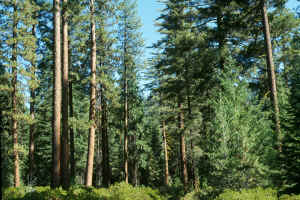 Physical Setting. This habitat generally occurs on the driest sites
supporting conifers in the Pacific Northwest. It is widespread and variable,
appearing on moderate to steep slopes in canyons, foothills, and on plateaus or
plains near mountains. In Oregon, this habitat can be maintained by the dry
pumice soils, and in Washington it can be associated with serpentine soils.
Average annual precipitation ranges from about 14 to 30 inches (36 to 76 cm) on
ponderosa pine sites in Oregon and Washington and often as snow. This habitat
can be found at elevations of 100 ft (30m) in the Columbia River Gorge to dry,
warm areas over 6,000 ft (1,829 m). Timber harvest, livestock grazing, and
pockets of urban development are major land uses. Physical Setting. This habitat generally occurs on the driest sites
supporting conifers in the Pacific Northwest. It is widespread and variable,
appearing on moderate to steep slopes in canyons, foothills, and on plateaus or
plains near mountains. In Oregon, this habitat can be maintained by the dry
pumice soils, and in Washington it can be associated with serpentine soils.
Average annual precipitation ranges from about 14 to 30 inches (36 to 76 cm) on
ponderosa pine sites in Oregon and Washington and often as snow. This habitat
can be found at elevations of 100 ft (30m) in the Columbia River Gorge to dry,
warm areas over 6,000 ft (1,829 m). Timber harvest, livestock grazing, and
pockets of urban development are major land uses.
Landscape Setting. This woodland habitat typifies the lower treeline zone
forming transitions with Eastside Mixed Conifer Forest and Western Juniper and
Mountain Mahogany Woodland, Shrubsteppe, Eastside Grassland, or Agriculture
habitats. Douglas-fir-ponderosa pine woodlands are found near or within the
Eastside Mixed Conifer Forest habitat. Oregon oak woodlands appear in the driest
most restricted landscapes in transition to Eastside Grassland or Shrubsteppe.
 Structure. This habitat is typically a woodland or savanna with tree
canopy coverage of 10- 60%, although closed-canopy stands are possible. The tree
layer is usually composed of widely spaced large conifer trees. Many stands tend
towards a multilayered condition with encroaching conifer regeneration. Isolated
taller conifers above broadleaf deciduous trees characterize part of this
habitat. Deciduous woodlands or forests are an important part of the structural
variety of this habitat. Clonal deciduous trees can create dense patches across
a grassy landscape rather than scattered individual trees. The undergrowth may
include dense stands of shrubs or, more often, be dominated by grasses, sedges,
or forbs. Shrubsteppe shrubs may be prominent in some stands and create a
distinct tree-shrub-sparse-grassland habitat. Structure. This habitat is typically a woodland or savanna with tree
canopy coverage of 10- 60%, although closed-canopy stands are possible. The tree
layer is usually composed of widely spaced large conifer trees. Many stands tend
towards a multilayered condition with encroaching conifer regeneration. Isolated
taller conifers above broadleaf deciduous trees characterize part of this
habitat. Deciduous woodlands or forests are an important part of the structural
variety of this habitat. Clonal deciduous trees can create dense patches across
a grassy landscape rather than scattered individual trees. The undergrowth may
include dense stands of shrubs or, more often, be dominated by grasses, sedges,
or forbs. Shrubsteppe shrubs may be prominent in some stands and create a
distinct tree-shrub-sparse-grassland habitat.
Composition. Ponderosa pine (Pinus ponderosa) and Douglas-fir (Pseudotsuga
menziesii) are the most common evergreen trees in this habitat. The
deciduous conifer, western larch (Larix occidentalis), can be a
co-dominant with the evergreen conifers in the Blue Mountains of Oregon, but
seldom as a canopy dominant. Grand fir (Abies grandis) may be frequent in
the undergrowth on more productive sites giving stands a multilayer structure.
In rare instances, grand fir can be co-dominant in the upper canopy. Tall
ponderosa pine over Oregon white oak (Quercus garryana) trees form stands
along part of the east Cascades. These stands usually have younger cohorts of
pines. Oregon white oak dominates open woodlands or savannas in limited areas.
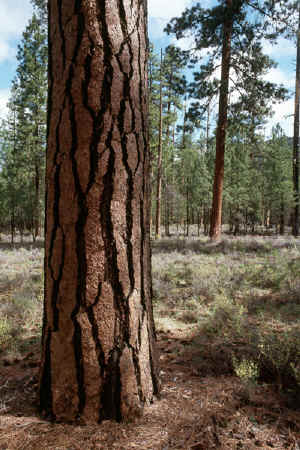 The undergrowth can include dense stands of shrubs or, more often, be
dominated by grasses, sedges, and/or forbs. Some Douglas-fir and ponderosa pine
stands have a tall to medium-tall deciduous shrub layer of mallowleaf ninebark (Physocarpus
malvaceus) or common snowberry (Symphoricarpos albus). Grand fir
seedlings or saplings may be present in the undergrowth. Pumice soils support a
shrub layer represented by green-leaf or white-leaf manzanita (Arctostaphylos
patula or A. viscida). Short shrubs, pinemat manzanita (Arctostaphylos
nevadensis) and kinnikinnick (A. uva-ursi) are found across the range
of this habitat. Antelope bitterbrush (Purshia tridentata), big sagebrush
(Artemisia tridentata), black sagebrush (A. nova), green
rabbitbrush (Chrysothamnus viscidiflorus), and in southern Oregon,
curl-leaf mountain mahogany (Cercocarpus ledifolius) often grow with
Douglas-fir, ponderosa pine and/or Oregon white oak, which typically have a
bunchgrass and shrubsteppe ground cover. The undergrowth can include dense stands of shrubs or, more often, be
dominated by grasses, sedges, and/or forbs. Some Douglas-fir and ponderosa pine
stands have a tall to medium-tall deciduous shrub layer of mallowleaf ninebark (Physocarpus
malvaceus) or common snowberry (Symphoricarpos albus). Grand fir
seedlings or saplings may be present in the undergrowth. Pumice soils support a
shrub layer represented by green-leaf or white-leaf manzanita (Arctostaphylos
patula or A. viscida). Short shrubs, pinemat manzanita (Arctostaphylos
nevadensis) and kinnikinnick (A. uva-ursi) are found across the range
of this habitat. Antelope bitterbrush (Purshia tridentata), big sagebrush
(Artemisia tridentata), black sagebrush (A. nova), green
rabbitbrush (Chrysothamnus viscidiflorus), and in southern Oregon,
curl-leaf mountain mahogany (Cercocarpus ledifolius) often grow with
Douglas-fir, ponderosa pine and/or Oregon white oak, which typically have a
bunchgrass and shrubsteppe ground cover.
Undergrowth is generally dominated by herbaceous species, especially
graminoids. Within a forest matrix, these woodland habitats have an open to
closed sodgrass undergrowth dominated by pinegrass (Calamagrostis rubescens),
Geyer’s sedge (Carex geyeri), Ross’ sedge (C. rossii), long-stolon
sedge (C. inops), or blue wildrye (Elymus glaucus). Drier savanna
and woodland undergrowth typically contains bunchgrass steppe species, such as
Idaho fescue (Festuca idahoensis), rough fescue (F. campestris),
bluebunch wheatgrass (Pseudoroegneria spicata), Indian ricegrass (Oryzopsis
hymenoides), or needlegrasses (Stipa comata, S. occidentalis). Common
exotic grasses that may appear in abundance are cheatgrass (Bromus tectorum),
and bulbous bluegrass (Poa bulbosa). Forbs are common associates in this
habitat and are too numerous to be listed.
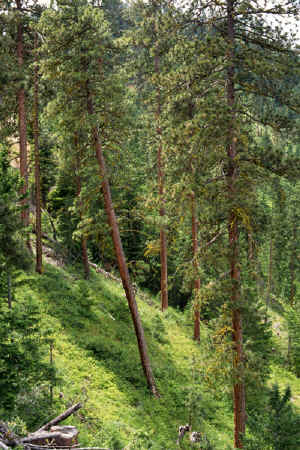 Other Classifications and Key References. This habitat is referred to as
Merriam’s Arid Transition Zone, Western ponderosa forest (Pinus), and
Oregon Oak wood (Quercus) in Kuchler 136, and as Pacific
ponderosa pine-Douglas-fir and Pacific ponderosa pine, and Oregon white oak by
the Society of American Foresters. The Oregon Gap II Project 126 and
Oregon Vegetation Landscape-Level Cover Types 127 that would
represent this type are ponderosa pine forest and woodland, ponderosa pine-white
oak forest and woodland, and ponderosa pine-lodgepole pine on pumice. Other
references describe elements of this habitat 45, 62, 88, 117, 118, 121,
122, 123, 144, 148, 209, 212, 221, 222. Other Classifications and Key References. This habitat is referred to as
Merriam’s Arid Transition Zone, Western ponderosa forest (Pinus), and
Oregon Oak wood (Quercus) in Kuchler 136, and as Pacific
ponderosa pine-Douglas-fir and Pacific ponderosa pine, and Oregon white oak by
the Society of American Foresters. The Oregon Gap II Project 126 and
Oregon Vegetation Landscape-Level Cover Types 127 that would
represent this type are ponderosa pine forest and woodland, ponderosa pine-white
oak forest and woodland, and ponderosa pine-lodgepole pine on pumice. Other
references describe elements of this habitat 45, 62, 88, 117, 118, 121,
122, 123, 144, 148, 209, 212, 221, 222.
Natural Disturbance Regime. Fire plays an important role in creating
vegetation structure and composition in this habitat. Most of the habitat has
experienced frequent low-severity fires that maintained woodland or savanna
conditions. A mean fire interval of 20 years for ponderosa pine is the shortest
of the vegetation types listed by Barrett et al.22. Soil drought
plays a role in maintaining an open tree canopy in part of this dry woodland
habitat.
Succession and Stand Dynamics. This habitat is climax on sites near the
dry limits of each of the dominant conifer species and is more seral as the
environment becomes more favorable for tree growth. Open seral stands are
gradually replaced by more closed shade-tolerant climax stands. Oregon white oak
can reproduce under its own shade but is intolerant of overtopping by conifers.
Oregon white oak woodlands are considered fire climax and are seral to conifers.
In drier conditions, unfavorable to conifers, oak is climax. Oregon white oak
sprouts from the trunk and root crown following cutting or burning and form
clonal patches of trees.
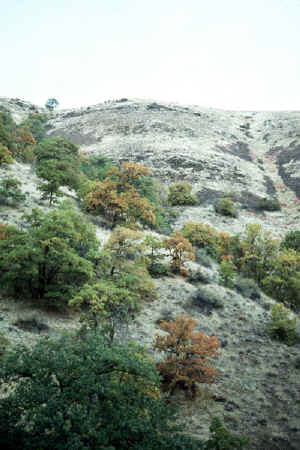 Effects of Management and Anthropogenic Impacts. Pre-1900, this habitat
was mostly open and park like with relatively few undergrowth trees. Currently,
much of this habitat has a younger tree cohort of more shade-tolerant species
that gives the habitat a more closed, multilayered canopy. For example, this
habitat includes previously natural fire-maintained stands in which grand fir
can eventually become the canopy dominant. Fire suppression has lead to a
buildup of fuels that in turn increase the likelihood of stand-replacing fires.
Heavy grazing, in contrast to fire, removes the grass cover and tends to favor
shrub and conifer species. Fire suppression combined with grazing creates
conditions that support cloning of oak and invasion by conifers. Large late-seral
ponderosa pine, Douglas-fir, and Oregon white oak are harvested in much of this
habitat. Under most management regimes, typical tree size decreases and tree
density increases in this habitat. Ponderosa pine-Oregon white oak habitat is
now denser than in the past and may contain more shrubs than in presettlement
habitats. In some areas, new woodlands have been created by patchy tree
establishment at the forest-steppe boundary. Effects of Management and Anthropogenic Impacts. Pre-1900, this habitat
was mostly open and park like with relatively few undergrowth trees. Currently,
much of this habitat has a younger tree cohort of more shade-tolerant species
that gives the habitat a more closed, multilayered canopy. For example, this
habitat includes previously natural fire-maintained stands in which grand fir
can eventually become the canopy dominant. Fire suppression has lead to a
buildup of fuels that in turn increase the likelihood of stand-replacing fires.
Heavy grazing, in contrast to fire, removes the grass cover and tends to favor
shrub and conifer species. Fire suppression combined with grazing creates
conditions that support cloning of oak and invasion by conifers. Large late-seral
ponderosa pine, Douglas-fir, and Oregon white oak are harvested in much of this
habitat. Under most management regimes, typical tree size decreases and tree
density increases in this habitat. Ponderosa pine-Oregon white oak habitat is
now denser than in the past and may contain more shrubs than in presettlement
habitats. In some areas, new woodlands have been created by patchy tree
establishment at the forest-steppe boundary.
Status and Trends. Quigley and Arbelbide 181 concluded that
the Interior Ponderosa Pine cover type is significantly less in extent than
pre-1900 and that the Oregon White Oak cover type is greater in extent than
pre-1900. They included much of this habitat in their Dry Forest potential
vegetation group 181, which they concluded has departed from natural
succession and disturbance conditions. The greatest structural change in this
habitat is the reduced extent of the late-seral, single-layer condition. This
habitat is generally degraded because of increased exotic plants and decreased
native bunchgrasses. One third of Pacific Northwest Oregon white oak, ponderosa
pine, and dry Douglas-fir or grand fir community types listed in the National
Vegetation Classification are considered imperiled or critically imperiled 10.
[ Top ]
[ Literature Citations ]
[ Wildlife-Habitat Types - Table 1 ]
|